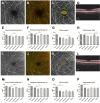Quantitative detection of macular microvascular abnormalities identified by optical coherence tomography angiography in different hematological diseases
- PMID: 39455721
- PMCID: PMC11511973
- DOI: 10.1038/s41598-024-76753-8
Quantitative detection of macular microvascular abnormalities identified by optical coherence tomography angiography in different hematological diseases
Abstract
It is now understood that hematological diseases can have detrimental effects on the retina, reducing retinal capillaries, compromising visual function, and potentially causing irreversible visual impairment. Over the years, there has been limited research on macular microvascular abnormalities, such as changes in vessel density and the foveal avascular zone (FAZ) and variations in the severity of these effects across different types of blood disorders. This study aims to quantitatively assess the impact of various hematological disorders on the retina using optical coherence tomography angiography (OCTA). Compared with healthy eyes, patients with different blood diseases exhibited reductions in linear vessel density (LVD), perfusion vessel density (PVD), FAZ area, and FAZ perimeter. Notably, patients with erythrocyte diseases showed more significant abnormalities in LVD and PVD, while patients with lymphocytic diseases demonstrated more pronounced abnormalities in the FAZ area and perimeter. OCTA imaging could potentially reflect changes of the retinal microvascular of patients with hematological diseases and may serve as a valuable tool for distinguishing abnormalities affecting different blood cell lines. This approach offers a novel avenue for assessing, treating, and monitoring blood disorders.
Keywords: Erythrocyte diseases; Lymphocyte diseases; Myelocyte diseases; Optical coherence tomography angiography; Pancytopenia diseases.
© 2024. The Author(s).
Conflict of interest statement
The authors declare no competing interests.
Figures


Similar articles
-
Assessment of macular microvasculature features before and after vitrectomy in the idiopathic macular epiretinal membrane using a grading system: An optical coherence tomography angiography study.Acta Ophthalmol. 2021 Nov;99(7):e1168-e1175. doi: 10.1111/aos.14753. Epub 2021 Jan 10. Acta Ophthalmol. 2021. PMID: 33423352
-
Evaluation of microvascular network with optical coherence tomography angiography (OCTA) in branch retinal vein occlusion (BRVO).BMC Ophthalmol. 2020 Apr 19;20(1):154. doi: 10.1186/s12886-020-01405-0. BMC Ophthalmol. 2020. PMID: 32306978 Free PMC article.
-
Reproducibility of Foveal Avascular Zone and Superficial Macular Retinal Vasculature Measurements in Healthy Eyes Determined by Two Different Scanning Protocols of Optical Coherence Tomography Angiography.Ophthalmic Res. 2020;63(3):244-251. doi: 10.1159/000503071. Epub 2019 Oct 16. Ophthalmic Res. 2020. PMID: 31618736
-
Application of Optical Coherence Tomography Angiography Macular Analysis for Systemic Hypertension. A Systematic Review and Meta-analysis.Am J Hypertens. 2022 Apr 2;35(4):356-364. doi: 10.1093/ajh/hpab172. Am J Hypertens. 2022. PMID: 34718393
-
Microstructural and hemodynamic changes in the fundus after pars plana vitrectomy for different vitreoretinal diseases.Graefes Arch Clin Exp Ophthalmol. 2024 Jul;262(7):1977-1992. doi: 10.1007/s00417-023-06303-x. Epub 2023 Nov 20. Graefes Arch Clin Exp Ophthalmol. 2024. PMID: 37982887 Review.
References
-
- Hemminki, K., Huang, W., Sundquist, J., Sundquist, K. & Ji, J. Autoimmune diseases and hematological malignancies: exploring the underlying mechanisms from epidemiological evidence. Semin Cancer Biol. Aug. 64, 114–121 (2020). - PubMed
-
- Hu, D. et al. Cellular senescence and hematological malignancies: from pathogenesis to therapeutics. Pharmacol. Ther. Jul. 223, 107817 (2021). - PubMed
-
- Zhao, E. J., Cheng, C. V., Mattman, A. & Chen, L. Y. C. Polyclonal hypergammaglobulinaemia: assessment, clinical interpretation, and management. Lancet Haematol. May. 8 (5), e365–e375 (2021). - PubMed
MeSH terms
Grants and funding
- ZR202111120236/Natural Science Foundation for Young Scholars of Shandong Province of China
- WST2021004/Shandong Province "Double-Hundred Talent Plan" on 100 Foreign Experts and 100 Foreign Expert Teams Introduction (For Team)
- nos.81300383/Youth Fund of the National Natural Science Foundation of China
- nos. 2020SDUCRCC015/Novo Nordisk Haemophilia Research Fund (NNHRF) China Clinical Research Center of Shandong University
- tsqn202103167/Shandong Provincial People's Government, Mount Taishan Scholar Young Expert
LinkOut - more resources
Full Text Sources
Medical

